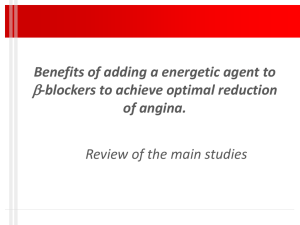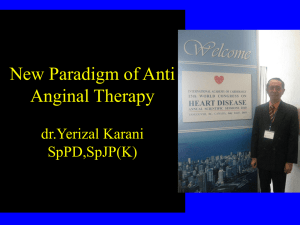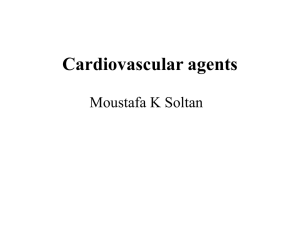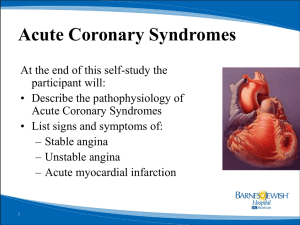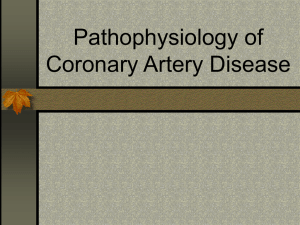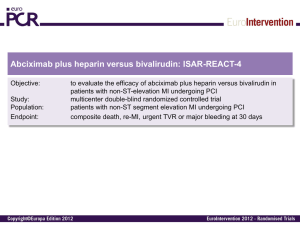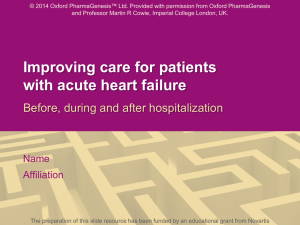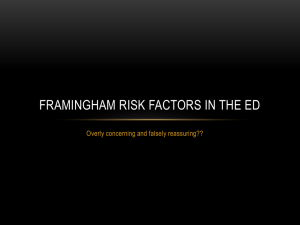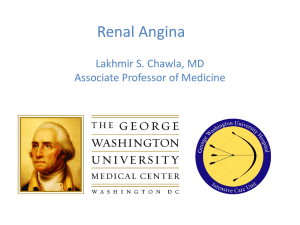Management of Acute Myocardial Infarction
advertisement
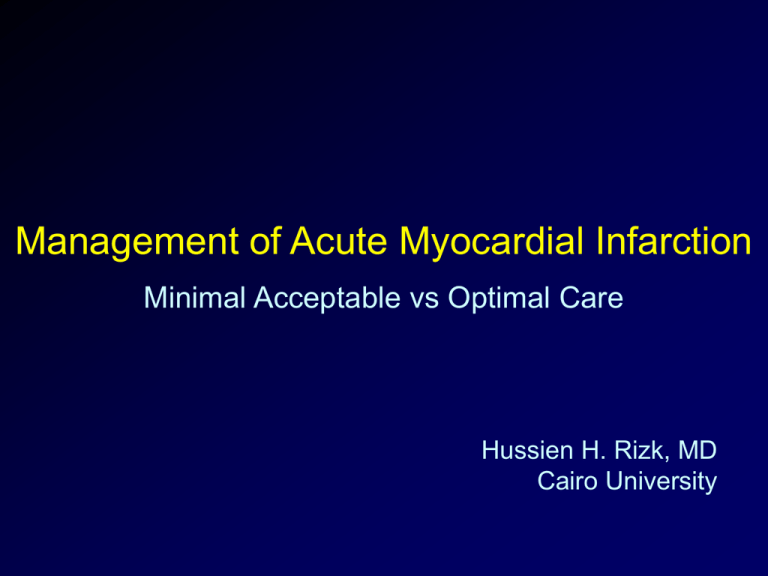
Management of Acute Myocardial Infarction Minimal Acceptable vs Optimal Care Hussien H. Rizk, MD Cairo University Background • Suspicious chest pain: extremely common cause of ER visits • Acute MI: the most costly cardiac cause of ER visits • 5-10% of acute MI patients are missed because of errors in symptom interpretation or missed ECG diagnosis • Many patients do not receive proven inexpensive effective therapy Clinical proceedings of a suspected MI • Symptom evaluation – Pain characteristics – Heart failure, syncope – Contraindication to SK • Relief of symptoms – Pain – Nausea – Anxiety • Physical examination • ECG • Aspirin – Quick – Interpretation correct • ACE-I • Lab work-up – Basic [Sugar. CRT. K. CK if no ST elevation] – CXR – Specific [Clinically guided] • Disposal: – – – – Discharge Observation Admission Referral – Saves as many lives as SK – Low dose [Captopril 6.25] – Not if SBP<100 • BB • Thrombolysis – SK – TPA: SK sensitive or recent use • Primary PCI: – Who? Where? Should everybody with acute MI have: • Statin? • Clopedogrel? • Platelet GP II b/III a inhibitor? • Primary PCI? Timing of Statin Therapy Initiation After ACS in Recent Clinical Studies Atorvastatin Pravastatin Simvastatin Fluvastatin MIRACL PROVE IT 4S WOSCOPS FLORIDA L-CAD ACS Primary prevention CARE LIPID Secondary prevention 0 6 12 18 24 2 Hours 4 6 8 10 12 3 Days 6 Months MIRACL Study Outcome Measures Primary –Death, Non-fatal MI, Cardiac arrest –Worsening angina + evidence of myocardial ischemia. Secondary –Stroke –Revascularization. –Worsening CHF –Worsening angina without evidence of ischemia Schwartz GG et al. JAMA 2001;255:1711 MIRACL Worsening Angina with New Objective Evidence Primary Urgent Efficacy Measure of MIRACL: Ischemia Requiring Hospitalisation Risk reduction = 16% P=0.048 15 Placebo 17.4% Atorvastatin 14.8% Cumulative Incidence 10 (%) 95% CI = 0.701–0.999 Time to first occurrence of composite endpoint8.4% of: Placebo 5 Death (any cause) Non-fatal MI ResuscitatedAtorvastatin cardiac arrest 6.2% Worsening angina withreduction new Risk = 26% objective evidence and urgent P=0.02 rehospitalisation 0 0 4 8 12 Time Since Randomisation (Weeks) 16 Schwartz GG et al. JAMA 2001;255:1711-8. MIRACL: COST-BENEFIT • Absolute risk reduction for worsening angina: 2.2% • NNT = 100/2.2 = 45.5 • Cost of avoiding one worsening angina event = NNT x No of Days x Daily cost (Ignoring lab tests & treating complications) = 45.5 x 120 X 36 = 196,364 LE GP II b/III a inhibitors for medically treated acute coronary syndromes • GUSTO 4-ACS: Abciximab, no acute revascularization. No benefit at 30D (Simoons. Lancet 2001;357:1915) or 1Y (Ottervanger et al. CIRCULATION 2003;107:437) • GRAPE pilot: abciximab for acute MI: TIMI 3 flow in 20% (van der Merkhof et al. JACC 1999;33:1528) • PRISM: Tirofiban reduced total mortality compared to heparin alone. Tirofiban in ACS: 1.5% ARR of 30D mortality compared to heparin alone PRISM. NEJM 1998;338:1498 NNT = 67 Cost/event = LE 130,000 • PRISM PLUS: terminated prematurely for excess mortality with tirofiban (4.6% vs 1.1% for heparin alone) DANAMI-2 COST-BENEFIT • • • • 6% Absolute risk reduction NNT = 16.7 Procedure cost: LE 14,000 Cost of preventing ONE EVENT (MI) at 30D = LE 233,800 MINIMAL ACCEPTABLE CARE FOR MI • CLINICAL TRAINING COST-EFFECTIVE • ROUTINE LAB: FBS. BUN. K. CK. CXR • ROUTINE Rx. SYMPTOMS. ASA. SK. BB. ACE-I • NOT ROUTINE: – – – – – TPA CLOPEDOGREL STATIN PLATELET GLYCOPROTEIN INHIBITORS PRIMARY PCI

